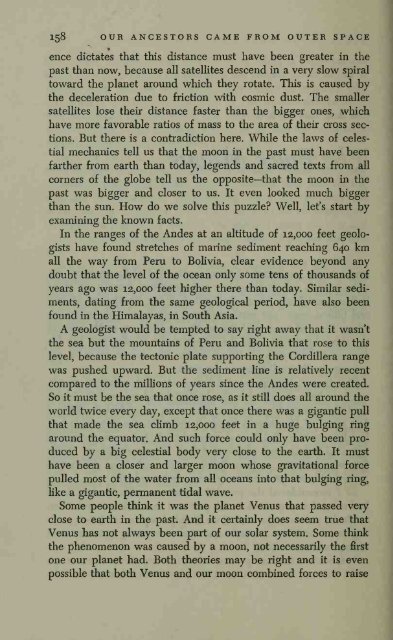Create successful ePaper yourself
Turn your PDF publications into a flip-book with our unique Google optimized e-Paper software.
158 OUR ANCESTORS CAME FROM OUTER SPACE<br />
ence dictates that this distance must have been greater in the<br />
past than now, because all satellites descend in a very slow spiral<br />
toward the planet around which they rotate. This is caused by<br />
the deceleration due to friction with cosmic dust. The smaller<br />
satellites lose their distance faster than the bigger ones, which<br />
have more favorable ratios of mass to the area of their cross sections.<br />
But there is a contradiction here. While the laws of celestial<br />
mechanics tell us that the moon in the past must have been<br />
farther from earth than today, legends and sacred texts from all<br />
corners of the globe tell<br />
us the opposite—that the moon in the<br />
past was bigger and closer to us. It even looked much bigger<br />
than the sun. How do we solve this puzzle? Well, let's start by<br />
examining the known facts.<br />
In the ranges of the Andes at an altitude of 12,000 feet geologists<br />
have found stretches of marine sediment reaching 640 km<br />
all the way from Peru to BoHvia, clear evidence beyond any<br />
doubt that the level of the ocean only some tens of thousands of<br />
years ago was 12,000 feet higher there than today. Similar sediments,<br />
dating from the same geological period, have also been<br />
found in the Himalayas, in South Asia.<br />
A geologist would be tempted to say right away that it wasn t<br />
the sea but the mountains of Peru and Bolivia that rose to this<br />
level, because the tectonic plate supporting the Cordillera range<br />
was pushed upward. But the sediment line is relatively recent<br />
compared to the millions of years since the Andes were created.<br />
So it must be the sea that once rose, as it still does all around the<br />
world twice every day, except that once there was a gigantic pull<br />
that made the sea cHmb 12,000 feet in a huge bulging ring<br />
around the equator. And such force could only have been produced<br />
by a big celestial body very close to the earth. It must<br />
have been a closer and larger moon whose gravitational force<br />
pulled most of the water from all oceans into that bulging ring,<br />
like a gigantic, permanent tidal wave.<br />
Some people think it was the planet Venus that passed very<br />
close to earth in the past. And it certainly does seem true that<br />
Venus has not always been part of our solar system. Some think<br />
the phenomenon was caused by a moon, not necessarily the first<br />
one our planet had. Both theories may be right and it is even<br />
possible that both Venus and our moon combined forces to raise

















